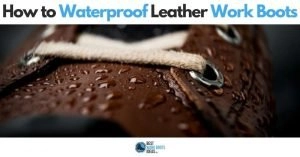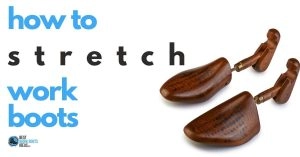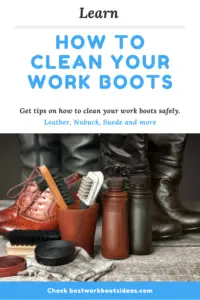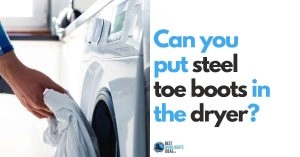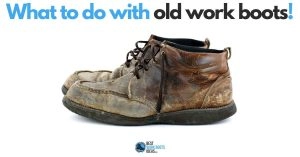How to Dry Wet Work Boots: Learn Hacks and Tips on avoiding chafing, blistering and discomfort.
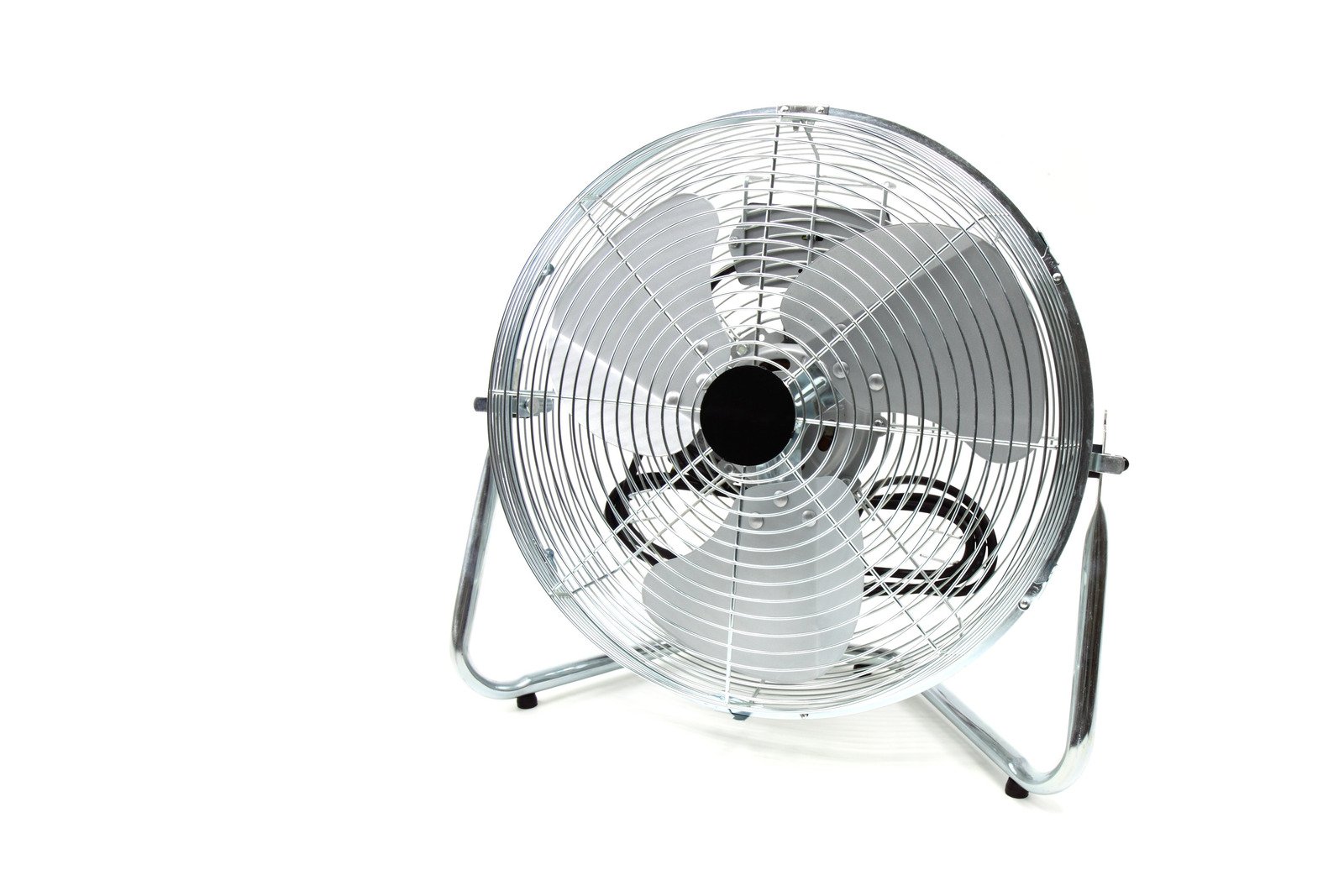

After a long day’s work in the rain or the mud, wet work boots can feel like the last straw when it comes to staying warm and dry. If you’re looking for a quick and easy way to dry your work boots, there’s no “one size fits all” solution.
Most fixes will take at least a few hours, so it’s best to let them work overnight. However, with a little time and patience, your boots should be back to normal in no time and ready to handle whatever you and the rest of the work week can throw at them!
Contents
The Problem With Wet Work Boots
The main problem with wet or water-logged work boots is the fit. If your shoes dry improperly, they may not fit the same way, or the material may warp and distort around the foot. This will leave you feeling cramped and uncomfortable all day long, and can lead to chafing and blistering issues.
If you notice that an old pair of shoes is no longer fitting as comfortably as it used to do, take a look at how you’ve been drying out any water. A little bit of extra time and caution when drying out wet boots can save you a world of hurt down the line.
The second major issue with wet shoes is the potential for dangerous infections. Your feet are already vulnerable to bacterial or fungal infection, and giving these microscopic threats a warm, moist place to grow only adds to the risk.
Especially because you’re most likely wearing your work boots in an environment that is rich with microorganisms, it is vitally important that you give your feet the best protection you can manage. Keeping your shoes and your feet clean and dry can go a long way towards protecting your feet from any nasty infections.
Finally, a third issue linked with wet shoes is the smell. Most shoes don’t smell amazing, but wet shoes can lead to a damp, mildewed scent that may linger for a long time.
The Importance of Keeping Your Shoes Dry
As mentioned above, wet shoes can lead to all sorts of unpleasant or downright disgusting fungal or bacterial infections that can greatly reduce your ability to go about your daily routine. Some of the most common include:
Athlete’s Foot: Athlete’s Foot is an infection that is usually marked by a red, scaly rash and is common among individuals with sweaty, usually-enclosed feet. It can be treated with over-the-counter antifungal medication but can persist or return for years to come.
Toenail Fungus: Toenail fungus is a sort of catch-all phrase to refer to a number of fungal infections that target the feet. If you notice your nails growing discolored or brittle, you may want to check with your doctor to make sure that you haven’t been infected.
Plantar Warts: Plantar warts usually appear on the weight-bearing areas of your feet like the heel and base of the toes. They will go away with proper treatment but can be uncomfortable.
Because of these medical concerns, along with similar conditions, it is absolutely vital that you keep your shoes clean and dry in order to avoid creating an environment where fungus and bacterial microorganisms will survive and thrive.
Before You Start to Dry Your Safety Shoes (Preparation)
Before you start drying your boots, try and break them down as much as possible. Remove the insoles and the laces, as well as any other attachments that can be removed. These parts will dry quicker on their own, and removing the extra water weight from your boots will give the boots themselves a better shot at a quick dry.
After you’ve removed any unnecessary parts from your boots, make sure you’ve cleaned your boots inside and out. Scrape off any excess dirt and use a leather or fabric cleaner to treat any areas with noticeable water damage or stains. This will speed up the drying process, but it will also keep your shoes from staining as the water dries, which will protect against damage and leave your shoes looking better for longer.
Finally, remove any excess water. This may seem like a no-brainer, but just take a few more moments to make sure that there isn’t any water pooled in the heel or the toe of both boots. This will greatly reduce the amount of time it takes for your boots to dry and save you from feeling frustrated and impatient when your boots are still soggy and wet.
Managing Your Expectations
Unfortunately, there really is no instantaneous cure to wet work boots. Because of their awkward shape and absorbent material, it’s going to take time to dry out a completely water-logged pair of shoes, no matter how many tips or tricks you memorize.
Because of the time factor, it may be best to leave your shoes to dry overnight, or whenever you know you’ll have a good chunk of time before you’ll need them again. Be patient and remember that longer drying times usually link to a lower risk of heat or dryness-related damage to your trusty pair of work boots.
How to Dry Work Boots
If you leave your boots to dry naturally, it can take up to forty-eight hours, which isn’t really practical for most people. If you’re wondering how to dry work boots quickly, consider:

Using a Fan
Find a powerful fan that is slightly larger than your work boots and make sure that it is anchored or otherwise fully stable on a hard surface.
After prepping your boots to be dried, hang them off of the fan so that the “mouth” of each boot is facing into the stream of air coming off the fan. This will evaporate any extra liquid and provide low-heat air circulation to dry your boots overnight or over the next few hours.
Using a Newspaper
For thinner boots, or if you have more time to monitor the drying process, try using some old newspapers to dry your boots.
After prepping your boots to dry, stuff them full of dry newspaper (scrunched up), packing the boots tightly in order to maintain their shape and soak up the water. Let the newspaper sit for at least an hour, and then remove the soaked paper and water and repeat the process until the insides of your boots are fully dried.
Using a Towel
Similar to the above entry, using an old towel can help you dry out your boots quickly and effectively. Take an old dry towel and stuff it into the boot in order to preserve shape and soak up moisture. Most towels will not fit entirely into the boot, but that’s okay!
Make sure to stuff the corners of the towel right upto the edges inside your safety shoe.
Use the excess material to wrap up the outside of the boot. This will let it dry from the inside and the outside at the same time, and should reduce overall time to dry!
For added good measure you can also use a fan.
Sun Drying
If you live in a place with plenty of sun, let nature do all the work for you! Drying your shoes in the sun will not only provide long-term exposure to an indirect heat source, but the ultraviolet rays of the sun will also treat your boots against bacteria, fungus and kill pathogens.
Of course, repeated exposure to the sun can damage your shoes over time, and this method may not be as efficient as some of the others, but it will still dry your boots completely.
Boot Dryers
If you find yourself constantly having to dry out your work boots, a boot dryer can be a great way to cut down on time and effort. A high-quality boot dryer such the one by Peet uses thermal radiation to dry out the insides of your boots and collect any dirty water that would otherwise drip onto your floor.
Boot dryers are also quicker than more traditional methods, which make them a great choice for those of us who have to constantly look for ways to save time.
You won’t need to be up all night checking on your work boots every few hours.
Just put the shoes on, turn a few switches and away you go.
For this reason, they can be a good investment from both a time and money perspective.
Shoe Inserts
Another commercial option for people who don’t want to deal with the hassle of setting up a fan is the use of shoe-drying inserts. Usually made of cedar or some other moisture-wicking filling, an insert is any object that you can place inside your shoe and leave overnight.
Most shoe inserts can be used more than once, and they may feature an antimicrobial coating that makes them safe to use over and over without fear of developing a bacterial or fungal culture to infect your shoes.
You should try and have at least two pairs of inserts that you can change.
Rice
Like the towels and the newspapers mentioned above, rice is a naturally absorbent material that soaks up water at an extremely fast rate. You may have heard of burying phones in rice to protect them from water damage, but the drying process for shoes works much the same way.
Place your boots inside a plastic container filled with about an inch of rice. Once you seal it, the rice should work to draw the water out of your boots over the next few hours.
Combinations
Any combination of the above drying methods will greatly reduce the time it takes to dry your shoes. Try wrapping your boots in towels before hanging them off the fan, or putting the sealed rice-and-boots container in a spot that gets direct sunlight.
As always, check on your boots whenever possible to make sure they’re drying properly and to change out any newspaper, rice, or towels that are fully saturated with water.
Once You’re Done (It’s Still Not Over)
Once your work boots are dry, there’s still a few more steps you should take to make sure that you get the most mileage out of your shoes. Proper care and keeping of your work boots will help to ensure that you can keep using your boots for years to come, no matter how water-logged they’ve become.
There are a lot of high-quality boot oils available on the market for various makes and models of work boots. If you’ve found a brand that you’re comfortable using, take a few minutes after your boots have dried to oil and polish the exterior surface.
Oiling your boots will help them look healthier and younger, but they can also help build up a protective layer against the elements. Even waterproof work boots can use a little bit of extra shine, and using a good, dependable oil will put another tool in your belt when it comes to fighting off stains and water damage marks.
This care is especially important after you’ve dried your work boots, as any long-time exposure to heat can age work boots prematurely and leave them looking dried-out, cracked, or otherwise damaged by the prolonged heat and movement of air.
Common Mistakes and Things To Avoid when Drying Work Boots
Most of the common mistakes that people make when drying out their work boots really boil down to heat. Your first instinct may be to place your wet boots in front of a direct heat source like a fire, stove, or radiator. Some may even find themselves reaching for a hairdryer in the hopes of cutting down the dry time by a few hours.
Do not place your boots in front of a direct heat source. As mentioned earlier, any exposure to heat runs a risk of damaging or aging your work boots prematurely. A direct or concentrated heat source is exponentially more likely to damage your boots and leave them looking old and cracked. Beyond aesthetic concerns, direct heat can also damage the glue that most shoemakers use to hold together the different layers of the soles, which will make your boots more likely to fall apart.
If you find yourself in a situation where you have no options except a direct heat source, make sure you place your boots at least three meters (about nine feet) away from the heat source in order to provide some level of protection against the intensely radiating heat.
Other Tips
Related to the above entry, try to keep your boots as cool as possible while they dry. Place them in a cool, dry room or in a cooler room in your house. This will keep your boots from expanding or absorbing any extra liquid as they dry off. In addition, avoid keeping them in a place that is too cool and look for the happy medium.
Look for a place that has a lot of space in addition to the right temperature. A good flow of air will help your shoes dry off more quickly and keep them from growing stale and musty-smelling. If you keep your shoes in a small space without a good air flow, you may unintentionally provide any fungus or bacteria with more hiding spaces and more damp, contaminated air to keep breeding in, even long after your work books are fully dried off.
If you’re worried about the smell that may still linger around your work boots, you can use cat litter or silica to soak up some of the odor. Cat litter, in particular, is designed to eliminate unpleasant odors and so will go a long way towards keeping your shoes smelling fresh.
Once They’re Dry
Once your boots are dry, you may want to consider using a UV sanitizer. This will kill off any extra bacteria and ensure that your work boots are ready for whatever your job can throw at them without damaging the underlying structure of the boots themselves.
In addition to using boot oil to polish your shoes, you can use saddle soap to buff up your boots and keep the leather looking soft and brand-new! This will also help proof your shoes against some run-of-the-mill damage— and keep you from having to go through the pain of drying them again.
Food for Thought
Of course, an ounce of prevention is worth a pound of cure — buy good, solid work boots that can hold up to some of the damage of the elements. A waterproof pair of boots will save you a lot of headache, and a thick pair of socks will protect your feet against the more insidious dangers of wet shoes.
Maintain your boots well even when they’re not wet and consider alternating pairs of boots so that no one pair gets too damaged. Take care of your boots and buy good boots to begin with—your feet will thank you for it!
Ultimately, preparation is key. Whether that means setting aside space in your home for a boot-drying rack or having extra insoles ready in case of an emergency, having a plan before you tackle a round of rough weather can really help you feel more in-control of the situation.
Dry the inside of the boot first, try to follow a natural process of drying, and make sure you take good care of your work boots once they’re fully dried, and you will be able to take your boots back out for just a little more of that daily wear and tear.

